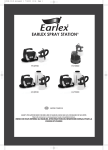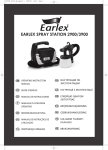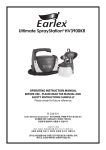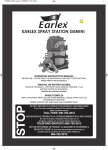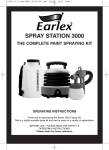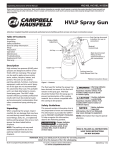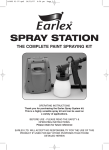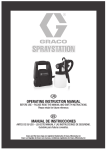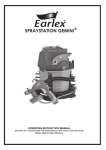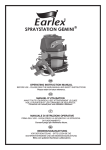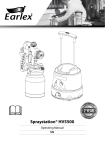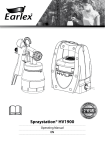Download Earlex HV3500 Instruction manual
Transcript
EARLEX SPRAY STATION HV2900/3900 HV3500 OPERATING INSTRUCTION MANUAL Thank you for purchasing the Earlex Spray Station. BEFORE USE – PLEASE READ THE MANUAL AND SAFETY INSTRUCTIONS. Please retain for future reference. EXPLODED PARTS VIEW Fig.1 3 2 5 4 6 7 9 8 10 11 1 B A 12 Fig.3 Fig.2 14 13 13 14 HV3500 HV2900/ 3900 2 PARTS LIST Fig.1 No.Description 1. Needle and Fluid Tip Tool 2. Air Cap Ring 3. Air Cap 4. Spray Direction Plate 5. Fluid Tip 2.0mm 6. Fluid Tip O-Ring PARTS LIST HV3500 Part Code V0018 V0001 V0002 V0003 V0004 V0005 No.Description 7. Fluid Needle 2.0mm 8. Lip Seal - Fluid Needle 9. Paint Flow Adjuster 10. Paint Container Seal 11. Pick-up Tube 12. Paint Container Part Code V0006 V0007 V0011 L0682 V0012 V0014 Fig.2 No.Description 13. Hose 14. Filter Part Code L1064 L0290 PARTS LIST HV2900/3900 Fig.3 No.Description 13. Hose 14. Filter Part Code L0896 L0290 SAFETY OPERATING INSTRUCTIONS PLEASE READ BEFORE USE • Never under any circumstances aim the Spray Gun at another person or animal. In the event of injury occurring seek expert medical advice immediately. • The Spray Gun must only be used with paints and solvents that have a flash point suitable for spraying. If in doubt, consult the paint or solvent manufacturer’s data. • Always ensure there is adequate ventilation when spraying. • NEVER spray near a naked flame, including appliance pilot light. • NEVER smoke whilst spraying. • NEVER allow children to operate or play with the Spray Gun. • Always read the solvent manufacturer’s instructions before use. • Always disconnect unit from mains supply when filling the paint container. • Always wear a suitable protective mask when spraying. We would also recommend the use of gloves, goggles and overalls. • After each use, thoroughly clean the Spray Gun. • This appliance is not intended for use by persons (including children) with reduced physical, sensory or mental capabilities, or lack of experience and knowledge, unless they have been given supervision or instruction concerning use of the appliance by a person responsible for their safety. • Use only genuine manufacturer replacement parts. • Always disconnect the Spray Station from the mains supply before cleaning the appliance. • Warning: The use of any accessory or attachment, other than those recommended in this instruction manual, may present a risk of personal injury. • Use the Spray Gun for the job it was designed for only. Mis-use of the Spray Gun will invalidate the guarantee. • Wear ear protection. WARNING: The substances used with this Spray Gun (paints, solvents, etc.) may contain dangerous, harmful, explosive or corrosive materials. ALWAYS COMPLY WITH THE SAFETY INSTRUCTIONS ISSUED WITH THIS PRODUCT AND THE MATERIAL BEING USED. INTRODUCTION The concept A motor feeds out a high volume of air (HV) and enables products to be sprayed at a low pressure (LP). The Hose feeds the air produced by the motor to the Spray Gun. The solution is released from the Fluid Tip of the Spray Gun at a very low pressure and is enclosed in a high volume of air. The powerful motor can spray a wide range of solutions with or without dilution. However, there will always be some which will not be suitable for the Spray Gun. Good quality paint contains a high percentage of solids which make the dilution easier. The users must keep in mind that low temperatures make the paint thicker, that’s why we recommend spraying with the Spray Gun at a 15°C minimum temperature. 3 PREPARATION • Carefully cover areas which are not to be painted with a plastic cover and protective tape. • Wear a suitable mask when spraying products (and make sure there is adequate ventilation in the room when working indoors). • Clean the surface you are going to paint. As well as being clean, it must also be dry and smooth. • Practice first on some old wooden planks to make sure you are holding the Spray Gun correctly. • We recommend you wear protective clothing. • Stir the paint well using a mixer where possible. • Make sure there are no solid particles in the paint. • Many products can be sprayed without being thinned. However, if the application is not good, thin the product progressively in stages of 5%. • Most paints can be sprayed by being thinned just a little, e.g. by 5% or 10%. • Some thick paints such as outer wall paints and certain undercoats will need to be thinned by 20% or 25%. • Use water to thin a water-based product. • Use appropriate thinner to thin solvent-based products. • Certain manufacturers will indicate on the can whether a specific thinner is to be used. • Certain paint manufacturers have specific paints available for HVLP application. DILUTION Dip the viscosity cup into the material and fill up. Check the guide below for the viscosity rating for your machines. Time how long it takes for the paint to stop being a continuous flow, from the bottom of the cup (Fig.4). If the paint requires thinning, start with a 5% dilution of the paint. To do this, part fill a container with one litre of paint. The viscosity cup supplied with the unit holds 1/10 of a litre, block the hole in the viscosity cup and fill up with the required thinner. Add the thinner to the paint and stir, measure the viscosity. If the paint requires further thinning, dilute the paint by another 5% (5% will be equal to half a viscosity cup) with the required thinner and measure the viscosity, if the paint is not at its recommended viscosity, repeat the above step. Viscosity Ratings The spray station 2900/3500 has a viscosity rating of 160 seconds. If the paint has emptied the viscosity cup in less than 160 seconds then you will not need to thin your paint or material. If it is above this then thinning will be required. The spray station 3900 has a viscosity rating of 180 seconds. If the paint has emptied the viscosity cup in less than 180 seconds then you will not need to thin your paint or material. If it is above this then thinning will be required. The spray pack has a viscosity rating of 70 seconds. If the paint has emptied the viscosity cup in less than 70 seconds then you will not need to thin your paint or material. If it is above this then thinning will be required. The above ratings are a guide, dependent on paint formulation further dilution may be required in increments of 5%. SET UP • Fill the Paint Container (12) with the product to be sprayed. Stir well (as mentioned previously) and strain to Fig.5 remove any bits which will interfere with a smooth consistent spray. • Make sure the Paint Container Seal (10) and Pick-up Tube (11) are firmly fitted into the base of the Spray Gun. • Screw the Paint Container (12) to the base of the Spray Gun and tighten accordingly. • Start with the Paint Flow Adjuster (9) at its minimum setting so the Trigger can not be pulled. Do not forget that the Paint Flow Adjuster controls the quantity of paint sprayed (Fig.4). • Uncoil the air Hose and attach it to the back of the Spray Gun and the other end to the Spray Station. • Uncoil the power cable and attach the plug to the mains supply. • Switch the Spray Station on. This will immediately cause some air to be produced, which is quite NORMAL. However, none of the product will be sprayed until the Spray Gun Trigger is pulled. • Very important: when spraying for the first time, we recommend that you always leave the motor unit to run for 1 to 2 minutes before applying the product. Do not forget that the Paint Flow Adjuster controls the quantity of paint sprayed (Fig.5). ALWAYS MAKE SURE THAT THE MOTOR UNIT IS ON A RIGID SURFACE AND FREE FROM DUST. SPRAYING Fig.6 Horizontal and Vertical Spray with varying widths Vertical and Horizontal for normal sized jobs HORIZONTAL Fig.7 3 Spray Patterns ROUND Round Spray Round for small and precise jobs VERTICAL 4 Fig.4 11 12 1 10 2 3 9 8 4 7 6 5 The most commonly used technique for painting a large surface is the ‘crisscross’ technique, i.e. you apply the product in a horizontal strips and then cross over these strips by applying the product in a vertical strips (Fig.7). 1) To achieve a horizontal strip adjust the Spray Direction Plate (4) to the vertical position then pull the Trigger and move your arm across to the right. Fig.7 2) When you get to the end of the line, release the Trigger for a moment and then apply the product in the opposite direction just beneath the line you have sprayed. 3) Next, to achieve a vertical strip adjust the Spray Direction Plate (4) to the horizontal position then pull the Trigger and move your arm up and down over the horizontal strips you just have sprayed. Fig.7 Through gradual movement of the Spray Direction Plate (4) between Horizontal, Vertical and Round spray pattern you can vary the width of the pattern (Fig.6) HINT: To obtain the best results always keep your Spray Gun level and at an equal distance from the object you are spraying, ideally 25-30cm (10“-12”) (Fig.8/9). Let your arm control the movement rather than your wrist (Fig.8/9). This will help give you an even paint distribution. Fig.8 Fig.9 HINT: HVLP technology produces warm air through the Air Cap allowing the paint to dry quicker which can enhance the final effect. HINT: Make sure the Pick-up Tube is properly oriented towards the handle for ceilings and away from the handle for floors. CLEANING INSTRUCTIONS SPRAY GUN Type of paint Cleaning Water based paint Clean with water Oiled based paint Clean with appropriate thinner e.g. White Spirit HINT: Before removing or re-inserting the Needle and Fluid Tip ensure the Spray Gun has been flushed through with water or the appropriate thinner so the inner tube is clean. HINT: When done immediately the cleaning operation can take you less than 5 minutes. If taking a break, leave the Spray Gun in a closed plastic bag to prevent the paint from drying. • Remove the Paint Container (12). • Pour any leftover paint into its container so that it can be used for the future. Pull the Trigger to allow paint to run out of the Pick-up Tube (11). • Pour a quantity of the respective thinner into container, shake the Spray Gun lightly, reassemble the Spray Gun, then spray this liquid though the Spray Gun. Repeat this until the thinner being sprayed is coming through with no traces of paint. • Clean any traces of paint off the outside of the Spray Gun. • Clean the Paint Container Seal (10). FLUID TIP AND NEEDLE • • • • • • • • • • • Unscrew Air Cap Ring (2). Remove the Air Cap (3). Remove the Spray Direction Plate (4). It is recommended that you push the Trigger forward to help release the Fluid Tip (5). Using the Needle and Fluid Tip Tool - pincer end A (1) remove the Fluid Tip (5). Insert the Needle and Fluid Tip end B (1) into the inner tube and unscrew the Needle anticlockwise, then pull to release the Needle. Place all of these items into a container and clean, then using a brush and the respective thinners. Clean the inside of the body of the Spray Gun. Thoroughly dry all parts before reassembling. Reassemble parts in reverse order. Ensure the Air Cap Ring (2) is fully tightened and the Fluid Tip is pushed into place so that the Spray Gun Needle will shut off. NB: Ensure the Spray Direction Plate is free to move. If necessary loosen the Air Cap Ring (2) slightly. • NEVER DISPOSE OF PAINTS OR SOLVENTS DOWN THE DRAIN. ALWAYS USE YOUR LOCAL WASTE COLLECTION SITE. • The motor unit itself does not require any specific maintenance apart from checking that the filter is not clogged up (the filter can be removed and washed). The filter can be found in the base of the motor unit. Important: Each Fluid Needle is manufactured to fit the size of the corresponding Fluid Tip. Do not try to fit a 2.0 mm Fluid Needle to a 3.0 mm Fluid Tip. 5 TROUBLESHOOTING PROBLEM CAUSE ACTION REQUIRED The paint drips onto item being painted Paint too diluted Add undiluted paint Paint output too high Reduce the paint output by adjusting the Paint Flow Adjuster (9) Moving too slowly Increase speed of application Spray Trigger held for too long Release Trigger sooner Spray Gun too close Increase the distance between the Spray Gun and the work surface Paint too diluted Add undiluted paint Paint output too low Increase the paint output by adjusting the Paint Flow Adjuster (9) Moving too fast Reduce speed of application Spray Gun clogged Clean the Spray Gun SPRAY GUN Paint is too thin or irregular No paint being released Spray Gun too far away Move the Spray Gun closer to the work surface Paint too thick Add thinner Fluid Tip clogged Clean the Fluid Tip (5) Pick-up Tube clogged Clean Pick-up Tube (11) Air Hose split Grainy paint Replace air Hose (13) Filter the paint Paint Container almost empty Refill Paint Container (12) Spray Gun at an angle Check that the Pick-up Tube (11) is pointing towards the paint Air inlet blocked Check the condition of the Filter (14) and clean if necessary Too much paint in an area You move your wrist Move your forearm instead Application Either too much or not enough paint Use the Paint Flow Adjuster (9) to control the flow 6 PLEASE NOTE: We have done all we can to ensure that when used correctly and in accordance with these instructions the spray gun has a long and fault-free life. We accept no responsibility for damage caused by the use of incorrect or unsuitable substances, paints or liquids which have not been thinned correctly or which are not suitable for the surfaces to which they are applied, health hazards arising from a lack of ventilation when working in confined spaces or equipment which is faulty due to inadequate cleaning of the components after use. If in doubt, test a small inconspicuous area first. Always read the manufacturer’s instructions before use. Neither our guarantee nor the above statement affects your statutory rights. MAINS CONNECTION This unit is a Class II appliance which means it is double insulated for your protection, no earthing wire is necessary. If the supply cord is damaged, it must be replaced by Earlex Ltd or our appointed agents. If you are using an extension lead it must be rated at a minimum of 6 amps and fully unwound. Do not operate with a lead rated at less the 6 amps as this will cause premature failure of the motor which is not covered by the guarantee. If the plug is cut off from the mains lead, it must be disposed of safely. NEVER under any circumstances insert a plug which is cut off from the mains lead into socket. Information on the disposal of waste electrical & electronic equipment is known as WEEE. Please do not dispose of tools with your household waste collected by the council. It is your responsibility to dispose of this type of waste by handing it over to a special designated collection point for recovery and recycling. EC Declaration of Conformity We declare that the unit: HV2900, 3500 and 3900 Conforms to LVD 2006/95/EC, EN60335-1, EMC 2004/108/EC, EN55014-1, EN55014-2, EN61000-3-2, EN61000-3-3, EMF EN50366, EN 62233 Tim Hopper Technical Director All rights reserved © 2011 Design Registrations and Patents: Spray Gun Design Registration ECD 001096218-0001 CN 200930004457.X US D609, 778S Spray Gun Patent GB 0903275.6 HV2900/HV3900 Turbine Design Registration GB 3022947 EU 000608856 US D563,503 HV3500 Turbine Design Registration ECD 001096242-0001 CN 200930004458.4 US 29/314,080 EARLEX LTD. WILL ACCEPT NO RESPONSIBILITY FOR THE USE OF THIS PRODUCT IF USED FOR ANY OTHER PURPOSES THAN THOSE DETAILED HEREIN. GUARANTEE and HELPLINE This product is guaranteed for a period of 24 months against faulty manufacture or materials. It is not guaranteed for industrial or hire purposes. This guarantee does not affect your statutory rights. For further information or any user advice, please phone our helpline between 08:30 to 17.00 Mondays to Thursday, Friday 08:30 to 15:45 (excluding Bank Holidays), or visit our website www.earlex.com. Earlex Ltd. Earlex Ltd, Tel: +44 (0)1483 454 666 Email: [email protected] Website: www.earlex.com 7 Earlex Ltd. Earlex Ltd, Tel: +44 (0)1483 454 666 Email: [email protected] Website: www.earlex.com V0082 09/11








